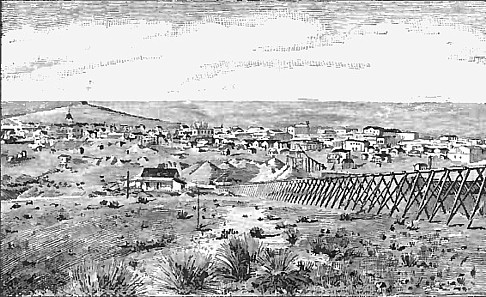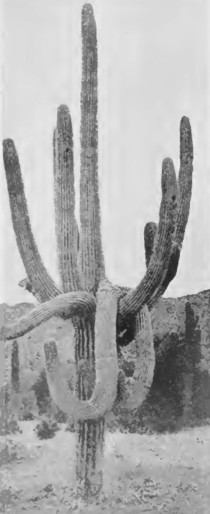This county is the oldest mining region in the United States. At what time the first discoveries were made by Europeans is not clear, although it is believed that the Jesuit missionaries operated here as early as the latter part of the seventeenth century. By the middle of the eighteenth century mining was prosecuted vigorously in the Baboquivari, the Santa Rita, Arivaca, Oro Blanco, Patagonia, and at several other points in the county. From the many old shafts and tunnels which have been discovered, it is evident that the industry was carried on extensively. In this region was found the famous "Planchas de Plata," or "planks of silver," which yielded nearly five tons of the pure metal. Many of the rich mines which were worked in those days, have not been found, although the most diligent search has been made. The abandonment of the missions in 1828, and the hostility of the Apaches, almost put a stop to mining in Arizona, and it was not until some time after the country came into the possession of the United States, that it was resumed. Several companies were then organized, and a great deal of bullion taken out. The constant raids of the savages, and the withdrawal of the troops, on the breaking out of the civil war, almost put a stop to all work, and not until the Indians were subdued, in 1874, did the mining industry of Pima county take a fresh start. This industry has received a wonderful impetus by the building of the Southern Pacific railroad. Millions of dollars have been invested; new districts have been organized; an army of prospectors has invaded the country, and many valuable discoveries have been made. Gold, silver, copper, and lead, are found in every mountain range in the county. With the exception of the region known as the Papagueria, wood and water is abundant everywhere. The richness of its ores and the size and permanent character of its veins, have given Pima county a reputation second to no portion of Arizona.
Harshaw District.—This district is about 70 miles south-east of Tucson, in the Patagonia mountains. The hills are covered with oak and juniper, while the water supply is sufficient for the working of ores. The camp is about 50 miles south of the Southern Pacific railroad. The Hermosa is a large lode of free milling ore. The vein is from 8 to 12 feet wide. The ore is a chloride and horn silver. One of the most complete 2 stamp mills on the coast is kept steadily at work, crushing about 80 tons per day. The yield of bullion up to date has been over $700,000. The mine is opened by a tunnel 700 feet in length, cutting the vein 300 feet below the croppings. A shaft has been sunk 100 feet below the level of this tunnel, and the mine is thoroughly opened by drifts and cross-cuts. The Hermosa is one of the leading mines of the Territory.
The Hardshell is a short distance west of the Hermosa. It shows a vein from 10 to 12 feet wide, of the same character of ore as the latter mine. It is opened by a shaft 50 feet deep, and by several cross-cuts. The Hardshell gives every promise of becoming one of the first mines of Pima county. The Trench is one of the old mines worked by the early missionaries, and carries some ore of a high grade. It shows a vein from 3 to 4 feet wide, carrying sulfides of silver. The main shaft is down 400 feet, and several levels have been opened. Steam hoisting works of the latest pattern have been erected. The Alta, south of the Hermosa, is opened by several shafts, and shows a large ore body. It is owned by Eastern parties. The Blue Nose, the American, the Independent, and many other fine prospects in this camp, show good ore and large veins.
Washington Camp This district is about nine miles south of Harshaw, and was formerly known as the Patagonia district. It is in the southern end of the Patagonia mountains, and has a delightful situation, being in the midst of a heavily timbered region. The Santa Cruz river, four miles distant, affords an inexhaustible supply of water. The district contains large veins of low-grade ore, carrying a heavy percentage of lead. The Davis is an immense vein of carbonates, being in places 20 feet wide. It has been opened by several shafts, the deepest being 500 feet, and also by drifts, cross-cuts, and winzes. The vein throughout all its workings shows large quantities of ore. The property is owned by the Patagonia Mining Company, who have erected a furnace on the Santa Cruz. The Belmont is one of the oldest locations in the district. It is three miles from the Sonora line. It has a shaft over 100 feet, and a cross-cut at the bottom showing 30 feet of carbonate ore, carrying considerable iron. The San Antonio is also an old location. It is opened, by three shafts, the deepest being GO feet. It shows a large body of ore similar in character to the Belmont. The Holland is another large body of smelting ore. A shaft has been sunk nearly 100 feet, showing a strong vein in the bottom. The "Washington is a vein, in places 30 feet wide. The copper ore carries iron and copper pyrites, and requires to be roasted. It is opened by several shafts and drifts. What is known as " Washing Pool mines" embrace the Grasshopper, St. Louis, Chicago, Ella, Ohio, Columbus, Blue Jay, and many others. They are all large veins, carrying ore of a good grade, though mixed with much base metal. The "Old Mowry mine " is four miles north of Washington camp. Before the breaking out of the civil war, the mine was worked by Lieutenant Mowry, giving employment to 400 men (principally Mexican). Large smelting works were erected, but the tall brick chimney is all that remains of the ruin. During the war the Apaches destroyed the building and machinery. The old shaft is down 350 feet. The ore is easily smelted, and carries from 40 to 60 per cent. lead. The mine is now owned by parties in Tucson. The Redoubtable, Pensacola, Pelican, Chico, Thurman, and scores of others show large veins, and many of them, have shafts from 60 to 70 feet. Washington Camp is favored beyond most districts in its natural facilities for ore reduction. This, together with its immense veins, should yet make it one of the leading districts in the Territory.
Tyndall District This is situated south of the high peaks, of the Santa Rita mountains and about sixty-five miles from Tucson. The ores of the district are generally of a good grade, but the rich ore bodies are not large. This camp has suffered from bad management by unscrupulous speculators. The mines are favorably situated near the Santa Cruz, while plenty of wood is found on the mountain sides. The Josephine is a vein 5 feet wide, of free-milling- ore that has worked $60 per ton. It is opened by a shaft 75 feet deep. The Emma shows a vein 6 feet wide, some of which has yielded $100 per ton. It has a 50-foot shaft. The Magnolia has 3 feet of milling ore that assays $70 per ton. It has a shaft 30 feet. The North Star has a shaft 50 feet, and shows a 5-foot vein that has yielded $50 per ton. The Bonanza is opened by an 80-foot shaft and shows over 7 feet of fine smelting ore. The Dayton is a 4-foot vein, some of which assays $150 per ton. There is a shaft on this mine 100 feet in depth. The Bushnell shows a 6-foot vein and a shaft over 100 feet. Some ore from this claim assays $300. It is a smelting ore. The Lost mine has a shaft 150 feet and a 4-foot vein assaying $60 per ton. The Major has a tunnel 100 feet in length. Its vein is 5 feet wide, and it has produced rock that has assayed $700. The Jefferson is a large body of smelting ore, nearly 7 feet wide. It has a shaft 150 feet in depth. The Red Cloud is a 3-foot vein of free-milling ore. It is opened by an 80-foot shaft, and has produced some very rich rock. The Laura, Happy Thought, Gold Tree, Helvetia, Red Oak, Hidalgo, Cachise, -Hamilton, Alcalde, Davis, Crown Point, and many other promising properties, are found in Tyndall district.
Aztec District: The Aztec District is really a continuation of the Tyndall. The character of the ore is the same and the formation similar. The veins are large and well defined, and can be traced for a long distance. The same causes which have retarded the development of the Tyndall district have also operated here. Among the claims which deserve mention, are the Empress of India, San Ignacio, Old Salaro mine, Rosario, Las Cruces, Ricard, Anahuac, Toltec, Coronado, Henry Clay, Apache, Santa Rita, Hidalgo, Seneca, La Salle, Juarez, and many others.
Return
to The Arizona Page:
Arizona Gold Rush Mining History



